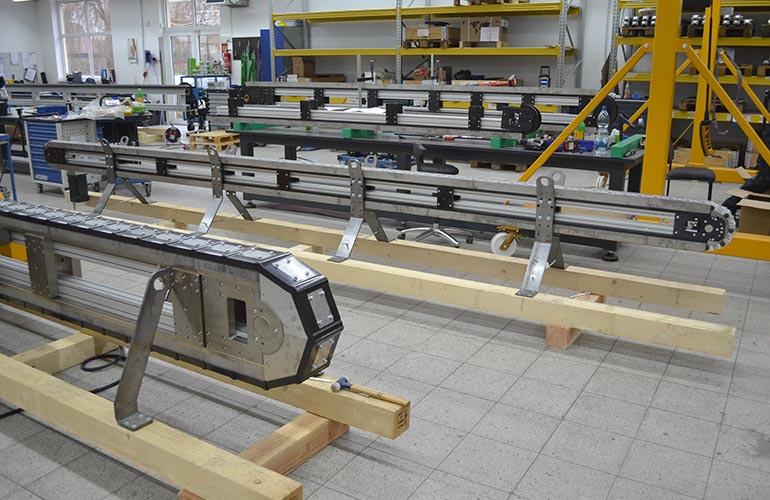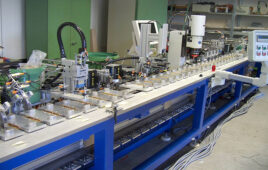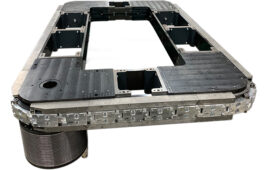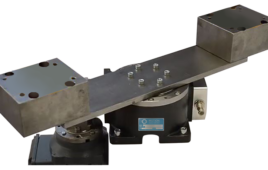
Is there a manufacturing process that is being automated that needs to move a product from station to station? If so, there will be a multitude of choices to accomplish this movement or transfer between stations. For engineers, designers, customers, and managers, the questions on what product to use always arise. Making a decision on when to use a precision link conveyor may include these questions:
- Are there multiple steps involved in the process, usually greater than 4?
- Is accuracy important to the manufacturing process, greater than +/-1mm (0.04’’)?
- Does the process need to have fast index times?
- Does the process require access to the product being manufactured from multiple directions?
- Does the transfer equipment need to be very compact and take up minimal floor space?
- Does the transfer equipment need to be very reliable, having a very long service life with minimal maintenance?
- Does the transfer equipment need to be sealed, with no grease, oil, or exposed contamination possible for the product?
If the answer to the questions above is YES, than a precision link conveyor may be the correct solution for the application. Precision link conveyors are used in a multitude of industries, from automotive to printing, from electronics to medical.
The precision link conveyor is not a typical conveyor. The conveyor is manufactured utilizing a rigid aluminum extrusion as its base chassis. This allows for very straight and rigid frame, while still keeping the mass of the conveyor low. This extrusion also allows the machine builder easy ways to mount accessories to the conveyor without having to drill and tap or modify a complicated structure.
Mounted to the frame is a machined, hardened, and ground steel track. This track is the track for the conveyor moving chain. This track can be nickel plated or black-oxided as desired. Riding in this track is the chain, which is made of custom machined aircraft grade aluminum links. Each link has four cam followers in it, providing guidance and high accuracy to the track. The links are driven by a cam wheel at the drive end, and a take up cam wheel at the take-up, non-drive end. The cam wheel at the drive end is then driven by a variety of devices. It can be driven by a very high accuracy Motion Index Drives, Inc. index drive with AC motor, or with servo motor, or simply with a high accuracy servo reducer and servo motor.
The conveyor itself is considered maintenance free in most medical applications. There is nothing to grease or oil as the index drives used are sealed completely. The cam followers are sealed and lubed for life on the conveyor track. No lubrication is required further. This is ideal for applications where the unit maybe installed in a clean room environment.
The accuracy and application decide what drives the conveyor. If the accuracy of +/-0.1mm (0.004’’) is enough, a precision link conveyor without index drive, but with high accuracy servo reducer is ok. But, if higher accuracy is required, up to +/-0.1mm (0.004’’), utilizing an index drive maybe required. Utilizing an index drive to obtain a fixed index stroke may also prove to be the simplest and most cost effective way of integrating the precision link conveyor into the manufacturing process as the motor is just a simple AC motor capable of being driven with an open loop variable frequency drive with no encoder feedback required.
So, how does one go about sizing, designing in, and budgeting for a precision link conveyor? The basics in getting a precision link conveyor application started can be found in the inquiry form below.
The most important questions are:
- What is the stroke required? Try to stick with a stroke that is one of the standard link sizes, or multiplier of to reduce These are 50, 80, 100, 125, 150, or 200mm. Multipliers can be 1, 2, 3, or 4 times the link pitch.
- Will the conveyor be mounted as a carousel, where both sides of the conveyor linear portion can be used, or as an over/under where the top is used?
- How many working stations are required? This is otherwise how many ‘steps’ are in the process to be done?
- How much is each tool and part going to Just a high level estimate is ok to start.
- What is the time required to do the index For example, 1.0 second to move 150mm.
- What accuracy is required or is standard ok?
- Are there any external forces or external conditions to be considered?
Precision link conveyors are custom made to order, so nothing is out of the question for the unit. From special hole patterns, custom holes in the center frame, special coatings, customized motor and drives, custom strokes, and more can be achieved.
A precision link conveyor can prove to be a very effective machine and also be the HEART of a manufacturing process. Many products can start as loose components and be a complete finished product at the end of the precision link process. If utilizing a precision link conveyor now appears to be a viable and effective solution for you, contact Motion Index Drives, Inc. to begin the process of getting a custom made to order precision link conveyor for your manufacturing facility.
Sponsored content by Motion Index Drives
Filed Under: Motion Index Drives Sponsored Content



